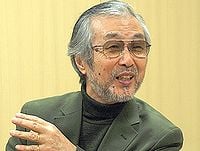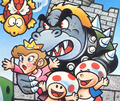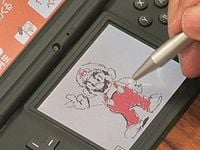Yoichi Kotabe: Difference between revisions
mNo edit summary |
m (→Career in the Animation Industry: added image) |
||
| Line 1: | Line 1: | ||
{{LLquote|When I first saw all the movements [[Mario]] was performing in [[Super Mario Bros.]], I thought that video games were now doing what the original animation industry was forgetting.|Yoichi Kotabe|Iwata Asks}} | {{LLquote|When I first saw all the movements [[Mario]] was performing in [[Super Mario Bros.]], I thought that video games were now doing what the original animation industry was forgetting.|Yoichi Kotabe|Iwata Asks}} | ||
[[File:Yoichi Kotabe.jpg|thumb|200px|'''Yoichi Kotabe''' during an interview conducted by [[Satoru Iwata]] in 2008.]] | |||
'''Yoichi Kotabe''' (小田部 羊一 ''Kotabe Yōichi'', born September 15, 1936) is a Japanese animation artist and former employee of [[Nintendo]]. In 1959, he entered the Japanese animation industry by joining [[wikipedia:Toei Animation|Toei Animation]]. After leaving the company, he also worked with other animation studios. During about two decades, Kotabe was involved in the making of many anime, such as ''[[wikipedia:Hols: Prince of the Sun|Hols: Prince of the Sun]]'', ''[[wikipedia:Panda! Go, Panda!|Panda! Go, Panda!]]'' and ''[[wikipedia:Heidi, Girl of the Alps|Heidi, Girl of the Alps]]''. In the late 1970s, he left the animation company he was employed at and started working freelance. Kotabe joined Nintendo in 1985, accepting a new challenge, and played an integral role in the development of the art and character design of different franchises, including the [[Mario (series)|''Mario'' series]]. With the instructions of [[Shigeru Miyamoto]], Kotabe redefined the look of major characters such as [[Mario]], [[Princess Peach]] and [[Bowser]]. He quit Nintendo in 2007 after 21 years, and is currently active as a freelancer. | '''Yoichi Kotabe''' (小田部 羊一 ''Kotabe Yōichi'', born September 15, 1936) is a Japanese animation artist and former employee of [[Nintendo]]. In 1959, he entered the Japanese animation industry by joining [[wikipedia:Toei Animation|Toei Animation]]. After leaving the company, he also worked with other animation studios. During about two decades, Kotabe was involved in the making of many anime, such as ''[[wikipedia:Hols: Prince of the Sun|Hols: Prince of the Sun]]'', ''[[wikipedia:Panda! Go, Panda!|Panda! Go, Panda!]]'' and ''[[wikipedia:Heidi, Girl of the Alps|Heidi, Girl of the Alps]]''. In the late 1970s, he left the animation company he was employed at and started working freelance. Kotabe joined Nintendo in 1985, accepting a new challenge, and played an integral role in the development of the art and character design of different franchises, including the [[Mario (series)|''Mario'' series]]. With the instructions of [[Shigeru Miyamoto]], Kotabe redefined the look of major characters such as [[Mario]], [[Princess Peach]] and [[Bowser]]. He quit Nintendo in 2007 after 21 years, and is currently active as a freelancer. | ||
| Line 11: | Line 11: | ||
===Career in the Animation Industry=== | ===Career in the Animation Industry=== | ||
[[File:Heidi concept art.jpg|thumb|Concept art for ''Heidi, Girl of the Alps'', one of Yoichi Kotabe's most famous works.]] | |||
During his first years at Toei Animation, Yoichi Kotabe had to learn about movement in animation. Someone else drew the main points, called key frames, within a movement, while newcomers like Kotabe cleaned up the work and drew the frames that would come in between. After about three years, Kotabe began to draw key frames himself. After that, he worked on a number of projects during about ten years. However, as stated by Kotabe in an interview, Toei Animation gradually came to prioritize profits. Even his own desire to create something fresh began to disappear. But then Kotabe worked on the anime film ''[[wikipedia:Hols: Prince of the Sun|Hols: Prince of the Sun]]'', which was directed by [[wikipedia:Isao Takahata|Isao Takahata]] and released to theaters in 1968. The director gave it all he had, and Kotabe was trying to keep up with him. After Kotabe was done working on the film, he was never afraid to work on anything else.<ref name="iwata_asks2">[http://www.nintendodsi.com/iwata-asks-chapter.jsp?interviewId=1&volumeId=8&chapterId=2 Iwata Asks: Nintendo DSi, Volume 8 - Yoichi Kotabe (page 2) at NintendoDSi.com]</ref> In 1963, Kotabe married fellow animator [[wikipedia:Reiko Okuyama|Reiko Okuyama]] (d. 2007<ref name="okuyama_death">[http://www.pelleas.net/aniTOP/index.php?title=reiko_okuyama_passes_away&more=1&c=1&tb=1&pb=1 Reiko Okuyama passes away (2007-09-14) at AniPages Daily]</ref>).<ref name="anido"/> | During his first years at Toei Animation, Yoichi Kotabe had to learn about movement in animation. Someone else drew the main points, called key frames, within a movement, while newcomers like Kotabe cleaned up the work and drew the frames that would come in between. After about three years, Kotabe began to draw key frames himself. After that, he worked on a number of projects during about ten years. However, as stated by Kotabe in an interview, Toei Animation gradually came to prioritize profits. Even his own desire to create something fresh began to disappear. But then Kotabe worked on the anime film ''[[wikipedia:Hols: Prince of the Sun|Hols: Prince of the Sun]]'', which was directed by [[wikipedia:Isao Takahata|Isao Takahata]] and released to theaters in 1968. The director gave it all he had, and Kotabe was trying to keep up with him. After Kotabe was done working on the film, he was never afraid to work on anything else.<ref name="iwata_asks2">[http://www.nintendodsi.com/iwata-asks-chapter.jsp?interviewId=1&volumeId=8&chapterId=2 Iwata Asks: Nintendo DSi, Volume 8 - Yoichi Kotabe (page 2) at NintendoDSi.com]</ref> In 1963, Kotabe married fellow animator [[wikipedia:Reiko Okuyama|Reiko Okuyama]] (d. 2007<ref name="okuyama_death">[http://www.pelleas.net/aniTOP/index.php?title=reiko_okuyama_passes_away&more=1&c=1&tb=1&pb=1 Reiko Okuyama passes away (2007-09-14) at AniPages Daily]</ref>).<ref name="anido"/> | ||
Revision as of 10:54, September 11, 2010

Yoichi Kotabe (小田部 羊一 Kotabe Yōichi, born September 15, 1936) is a Japanese animation artist and former employee of Nintendo. In 1959, he entered the Japanese animation industry by joining Toei Animation. After leaving the company, he also worked with other animation studios. During about two decades, Kotabe was involved in the making of many anime, such as Hols: Prince of the Sun, Panda! Go, Panda! and Heidi, Girl of the Alps. In the late 1970s, he left the animation company he was employed at and started working freelance. Kotabe joined Nintendo in 1985, accepting a new challenge, and played an integral role in the development of the art and character design of different franchises, including the Mario series. With the instructions of Shigeru Miyamoto, Kotabe redefined the look of major characters such as Mario, Princess Peach and Bowser. He quit Nintendo in 2007 after 21 years, and is currently active as a freelancer.
Life and Work
Early Life
Yoichi Kotabe was born in 1936 in Taipei, Taiwan. In 1945, after World War II, he went back to Japan and grew up in Hitachi, Ibaraki prefecture.[1] Early in his life, Kotabe became interested in art. His father painted oil paintings, and Yoichi Kotabe was always reading manga and copying the pictures as a child. When he learned from his mother how flip book animation worked, he started to draw some flip book animation himself. After that he was always interested in moving pictures. At school, Kotabe did hardly anything but doodle.[2]
When Yoichi Kotabe got out of high school, he studied Japanese-style painting at the Tokyo University of the Arts. Kotabe graduated, but initially he couldn't find a job. However, then the animation production company Toei Animation began recruiting. As a student, Kotabe was impressed by Toei's anime The Tale of the White Serpent (also known as Panda and the Magic Serpent). Kotabe invited two of his classmates to join the company, but unlike his classmates, he didn't get a job at Toei. Kotabe was crushed, but it wasn't long before they started recruiting again, and he finally joined the company in 1959.[2][1]
Career in the Animation Industry
During his first years at Toei Animation, Yoichi Kotabe had to learn about movement in animation. Someone else drew the main points, called key frames, within a movement, while newcomers like Kotabe cleaned up the work and drew the frames that would come in between. After about three years, Kotabe began to draw key frames himself. After that, he worked on a number of projects during about ten years. However, as stated by Kotabe in an interview, Toei Animation gradually came to prioritize profits. Even his own desire to create something fresh began to disappear. But then Kotabe worked on the anime film Hols: Prince of the Sun, which was directed by Isao Takahata and released to theaters in 1968. The director gave it all he had, and Kotabe was trying to keep up with him. After Kotabe was done working on the film, he was never afraid to work on anything else.[3] In 1963, Kotabe married fellow animator Reiko Okuyama (d. 2007[4]).[1]
After working at Toei Animation for about 12 years, he left the company in 1971. The production company known as A Production contacted Kotabe and his colleagues Isao Takahata and Hayao Miyazaki about adapting the Swedish children's book Pippi Longstocking.[1] The three animators left Toei, but the book's author Astrid Lindgren didn't give the permission. Kotabe and his fellow animators were at a complete loss, but then they were allowed to work on the film Panda! Go, Panda!, which was produced by Tokyo Movie Shinsha's film and released to theaters in 1972. Afterwards, the company Zuiyo Eizo approached Kotabe and his colleagues. The three men decided to leave Tokyo Movie and entered the next animation company. At Zuiyo, one of the productions they worked on was the anime series Heidi, Girl of the Alps, an adaption of the Swiss novel first broadcast in 1974.[3] Kotabe designed the titular protagonist Heidi and other characters.[5]
Career at Nintendo
In the late 1970s, Yoichi Kotabe left Zuiyo and started working freelance, as he began to feel like "water that's beginning to stagnate" after working on animation on the same place for a long time. As a freelancer, Kotabe only undertook pieces of larger works. While it was relieved of stress, it was not interesting for him. In 1985, he met Hiroshi Ikeda in a coffee shop, who was the manager of Nintendo EAD then. The two men knew each other from their work at Toei Animation. Ikeda asked Kotabe if he would like to join Nintendo and give advice about animation, as video games were going to require an increasing amount of know-how in animation. Kotabe knew very little about video games, but he believed Ikeda and agreed. Kotabe intended to be at Nintendo for only one or two years.[6]
At Nintendo, Kotabe was introduced to Shigeru Miyamoto and other developers. When they showed him the game Super Mario Bros., Kotabe saw the movements Mario was performing in the game, and he thought that video games were now doing what the original animation industry was forgetting. However, for a while after Kotabe joined Nintendo, he didn't work on animation at all and instead sat around doodling whatever came to his mind, as he said in an interview.[6] According to Miyamoto, the first animation Kotabe drew for Nintendo was of Luigi spinning around in circles, but it couldn't be used in a game as it had too many frames at the time. The first video game work Miyamoto requested from Kotabe was to draw the Magic Carpet in motion found in Yume Kojo: Doki Doki Panic. Miyamoto wanted it to move like a real rug, and so he asked Kotabe "Please, draw me a rug!" However, Kotabe's smoothly moving animation had too many frames, so their number had to be reduced while still keeping a smooth movement.[7]
Miyamoto also asked Kotabe to do many illustrations for Mario. As Mario was pixel art, the only reference was the package illustration for Super Mario Bros. Kotabe learned that Miyamoto was its artist, so he asked him many questions on how to draw Mario. With the instructions of Miyamoto, Kotabe created the image of Mario that became the new base for the visual development of Nintendo's mascot. Kotabe also redefined the look of other characters in the series. For example, Princess Peach completely changed, now being notably taller and wearing a different dress. Miyamoto told everything he wanted to Kotabe, like how he wanted her eyes to be a little cat-like, and how she should look stubborn, but charming. Bowser changed a lot as well. In Miyamoto's artwork, Bowser loosely resembled an ox as a homage to the ox king seen in the Journey to the West anime adaption that was renamed Alakazam the Great in the United States. Through their discussions, the developers began to see similar lines between Bowser and the Koopa Troopas and partly based Bowser's appearance on them. Bowser's new design eventually came together.[7] The following gallery shows a comparison between the illustrations of the three mentioned characters by Miyamoto and Kotabe:
- Mario SMB.png
Mario by Miyamoto
- Mariombros..PNG
Mario by Kotabe
- BowserSMB1.PNG
Bowser by Kotabe
Among other people who worked with Kotabe at Nintendo was game designer Yoshiaki Koizumi, a graduate from the Osaka University of Arts. Kotabe was the first person Koizumi worked together with after entering Nintendo. Koizumi was supposed to keep working as a character illustrator for a while, and Miyamoto told Kotabe to develop Koizumi's skills.[7]
Besides his skills in visual art, Kotabe also made use of other knowledge he acquired in the animation industry at Nintendo. For example, at Toei Animation, he was taught to look at "the real thing" and take it all inside oneself. Therefore, during the development of Super Mario Kart, Kotabe forced through a budget to inspect real go-karts. During their trip, the developers drove go-karts and observed their structure.[7]
After Kotabe became involved with Template:BP, including both the games and the anime series, Miyamoto and him hardly spent any more time working together. For example, for Template:BP, Kotabe took part in the creation of the 3D models of the various Pokémon.[7]
After 21 years at Nintendo, Kotabe left the company in 2007.[7][1] The last Mario series game in which his name appears in the credits is WarioWare: Smooth Moves. In total, more than 40 Mario games list Kotabe in the credits.[8]
After Nintendo
Yoichi Kotabe is currently active as a freelancer. He holds the post of a lecturer at Toei Animation Institute.[1] In 2008, a book titled Yoichi Kotabe: Legendary Animator - His Animated Drawings was released in Japanese, with a few contents also being in English.[5] It also includes information on Nintendo-related works of him.[9] In the same year an "Iwata Asks" interview was held with Yoichi Kotabe, Shigeru Miyamoto and Yoshiaki Koizumi. It focused on Yoichi Kotabe himself as well as the application Flipnote Studio for the Nintendo DSi. Kotabe created four animations with Flipnote Studio, including one of Mario, which were all made available at the Flipnote Hatena website.[10]
References
- ^ a b c d e f Yoichi Kotabe: Biographical Notes at Anido
- ^ a b Iwata Asks: Nintendo DSi, Volume 8 - Yoichi Kotabe (page 1) at NintendoDSi.com
- ^ a b Iwata Asks: Nintendo DSi, Volume 8 - Yoichi Kotabe (page 2) at NintendoDSi.com
- ^ Reiko Okuyama passes away (2007-09-14) at AniPages Daily
- ^ a b Yoichi Kotabe: Legendary Animator - His Animated Drawings at Anido
- ^ a b Iwata Asks: Nintendo DSi, Volume 8 - Yoichi Kotabe (page 3) at NintendoDSi.com
- ^ a b c d e f Iwata Asks: Nintendo DSi, Volume 8 - Yoichi Kotabe (page 4) at NintendoDSi.com
- ^ Yoichi Kotabe at MobyGames
- ^ Iwata Asks: Nintendo DSi, Volume 8 - Yoichi Kotabe (page 5) at NintendoDSi.com
- ^ Yoichi Kotabe at Flipnote Hatena


